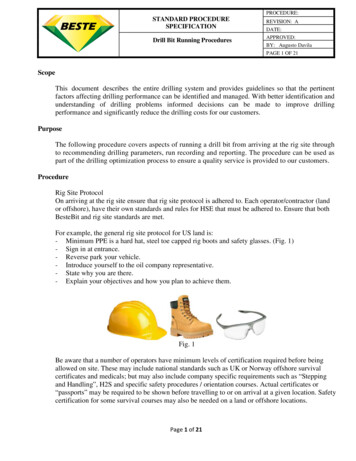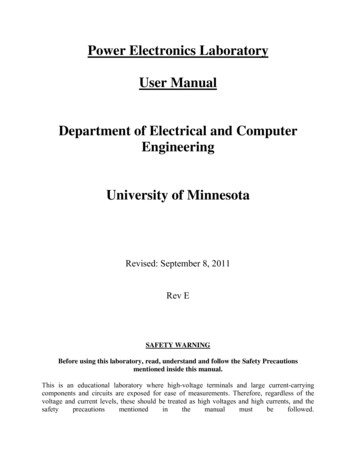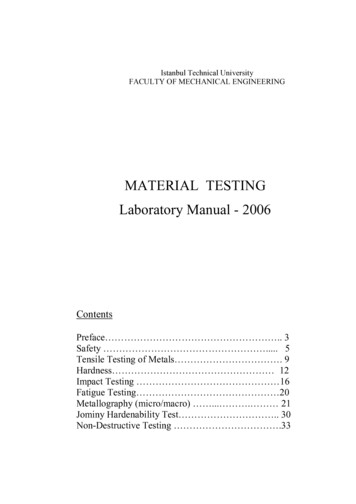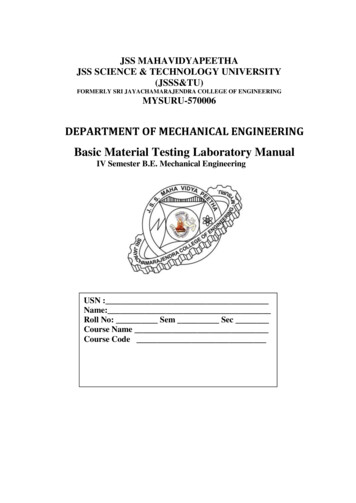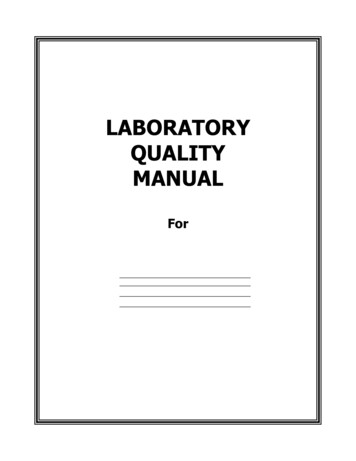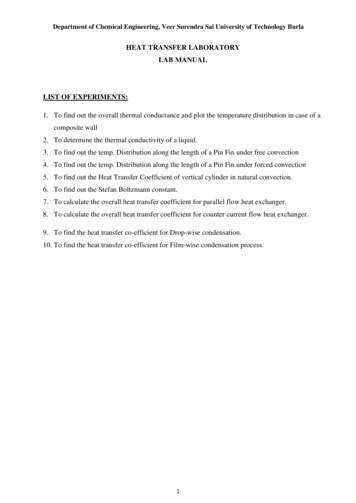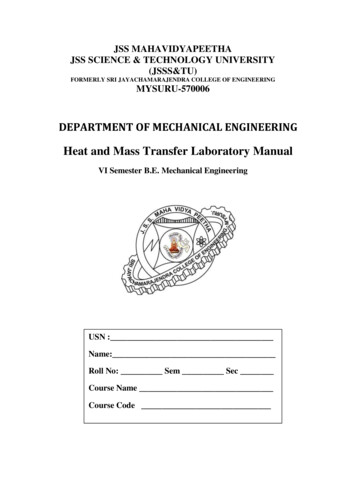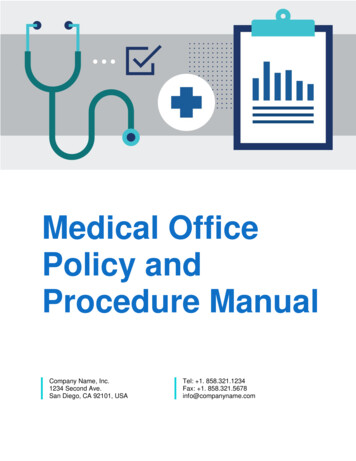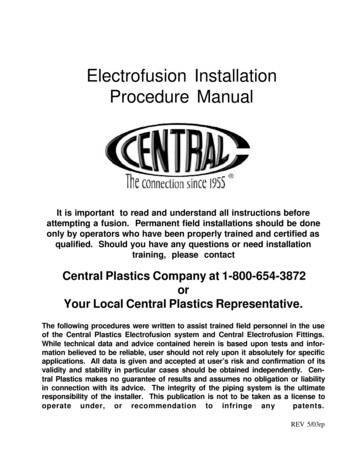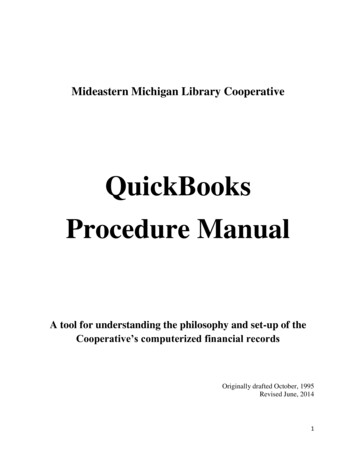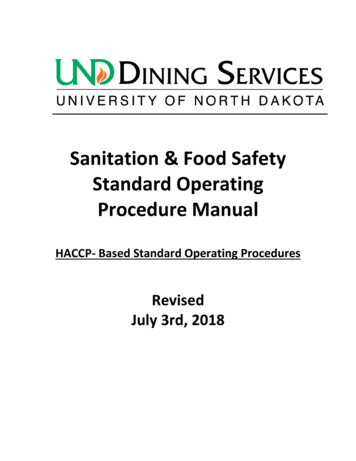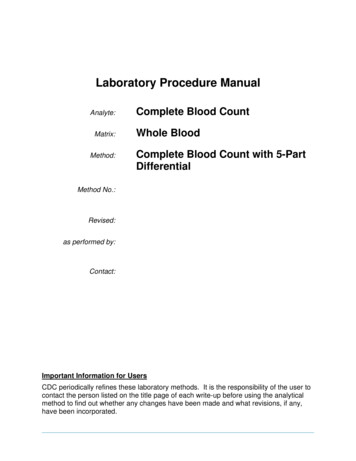
Transcription
Laboratory Procedure ManualAnalyte:Matrix:Method:Complete Blood CountWhole BloodComplete Blood Count with 5-PartDifferentialMethod No.:Revised:as performed by:Contact:Important Information for UsersCDC periodically refines these laboratory methods. It is the responsibility of the user tocontact the person listed on the title page of each write-up before using the analyticalmethod to find out whether any changes have been made and what revisions, if any,have been incorporated.
Complete Blood Count with 5 Part Differential in Whole BloodNHANES 2013-2014Public Release Data Set InformationThis document details the Lab Protocol for testing the items listed in the followingtable:LabNumberAnalyteSAS LabelLBXWBCSIWhite blood cell count (1000 cells/uL)LBXLYPCTLymphocyte (%)LBXMOPCT Monocyte (%)LBXNEPCTSegmented neutrophils (%)LBXEOPCTEosinophils (%)LBXBAPCTBasophils (%)LBDLYMNO Lymphocyte number (1000 cells/uL)CBC HLBDMONOMonocyte number (1000 cells/uL)LBDNENOSegmented neutrophils number (1000cells/uL)LBDEONOEosinophils number (1000 cells/uL)LBDBANOBasophils number (1000 cells/uL)LBXRBCSIRed cell count (million cells/uL)LBXHGBHemoglobin (g/dL)LBXHCTHematocrit (%)LBXMCVSIMean cell volume (fL)LBXMCHSIMean cell hemoglobin (pg)LBXMCMCHC (g/dL)LBXRDWRed cell distribution width (%)LBXPLTSIPlatelet count ((1000 cells/uL))LBXMPSIMean platelet volume (fL)
Complete Blood Count with 5 Part Differential in Whole BloodNHANES 2013-2014A complete blood count (CBC) is performed in duplicate on all study participants (SPs) aged 1 yearand older. The CBC is performed on the Coulter DxH 800 analyzer using the SP’s EDTA bloodtubes which are obtained via the phlebotomy component.I.Purpose and Principle of TestPurpose and Principle of TestThe UniCel DxH 800 analyzer is a quantitative, automated hematology analyzer for in-vitrodiagnostic use in screening patient populations in clinical laboratories. The UniCel DxH 800Analyzer provides the following: CBC, Leukocyte 5-Part Differential (Diff), Reticulocyte (Retic), andNucleated Red Blood Cell (NRBC) on whole blood.NOTE: The NHANES study does not use the reticulocyte data, and the NRBC is used only forcalculating a corrected white blood cell count.
Complete Blood Count with 5 Part Differential in Whole BloodNHANES 2013-2014The UniCel DxH 800 Analyzer measures the following NCWhite Blood Cell countUncorrected White Blood Cell countRed Blood Cell count (for Whole Blood and Body Fluids)HemoglobinHematocritMean Corpuscular VolumeMean Corpuscular HemoglobinMean Corpuscular Hemoglobin ConcentrationRed Cell Distribution WidthRed Cell Distribution Width Standard Deviation (SD)Platelet countMean Platelet VolumeNeutrophil percentLymphocyte percentMonocyte percentEosinophil percentBasophil percentNeutrophil absolute numberLymphocyte absolute numberMonocyte absolute numberEosinophil absolute numberBasophil absolute numberNucleated Red Blood Cell percentNucleated Red Blood Cell absolute numberReticulocyte percentReticulocyte absolute numberMean Reticulocyte VolumeImmature Reticulocyte FractionTotal Nucleated Cell (Body Fluids)
Complete Blood Count with 5 Part Differential in Whole BloodNHANES 2013-2014Coulter MethodIn 1956, Wallace Coulter described the Coulter Principle as follows: A suspension of blood cells ispassed through a small orifice simultaneously with an electric current. The individual blood cellspassing through the orifice introduce an impedance change in the orifice determined by the size ofthe cell.Each cell suspended in a conductive liquid (diluent) acts as an insulator. As each cell passes throughthe aperture, it momentarily increases the resistance of the electrical path between the submergedelectrodes on either side of the aperture. This causes a measurable electronic pulse. For purposes ofcounting, the vacuum used to pull the diluted suspension of cells through the aperture must be at aregulated volume. The number of recorded pulses indicates particle count, and the size of theelectrical pulse is proportional to the cell volume. In addition, the system counts the individual cellsand provides cell size distribution. The number of cells counted per sample is approximately 100times greater than the usual microscope count which reduces the odds of statistical errorapproximately 10 times.VCSn TechnologyHistorically, Beckman Coulter analyzers housed a flow cell in a Triple Transducer Module (TTM),which was first introduced commercially in the 1980’s. The TTM flow cell was the location fordetection of the processed samples. The TTM produced three measurement signals—volume,conductivity, and light scatter.The DxH 800 system replaces the TTM with the Multi-Transducer Module (MTM), which measuresadditional multiple angles of light scatter, a major improvement over the single light scattermeasured by the TTM. All Diff, NRBC, and Retic analysis occurs in the VCSn module. The VCSnmodule is responsible for controlled sample preparation and delivery of the prepared sample to theflow cell for analysis of the WBC differential, reticulocyte, and NRBC. The VCSn module includesthe Air Mix and Temperature Control (AMTC) and the Multi-Transducer Module (MTM).In the flow cell, low-frequency direct current measures volume, while high-frequency (RF) currentsenses cellular internal content through measuring changes in conductivity.The MTM uses a flow cell to pass particles through a sensing zone, one particle at a time, and adiode laser to illuminate the particles. The illuminated particles both scatter and absorb a portion of
Complete Blood Count with 5 Part Differential in Whole BloodNHANES 2013-2014the incident light. Sensors strategically placed around the flow cell collect the scattered light ofinterest. An additional sensor placed in the laser path measures the amount of light removed due tolight scatter and absorption. This measurement is called Axial Light Loss.Dataplot DevelopmentThe System Manager (SM) performs a series of operations on the stored digital raw values receivedfrom the flow cell to identify populations and calculate the frequency of cells within eachpopulation. The system produces the dataplot displays for visual representation of the Differential,NRBC membership (types of cells), and density (concentration).The DxH 800 system algorithm uses tools designed for finding optimal separation betweenoverlapping clusters of data.The algorithm can: Adapt to unusual population shifts and overlaps; Define highly irregular separation; Make subsequent analysis of the identified regions; and Correct deficiencies in separation.In the dataplots, different colors represent different memberships. Shades of colors representdensity: dark colors for low density and bright colors for high density, as shown in the followinglisting:NRBC AnalysisNRBCOther*WBCRedGreenBlueDiff philNon-White Cell* Others include RBC debris, and PLT debris, etc.BlueGreenPurpleOrangeWhiteRed
Complete Blood Count with 5 Part Differential in Whole BloodNHANES 2013-2014Parameter Measurement, Derivation, and CalculationThe following exhibit lists each reportable parameter and the method used to obtain the results. Adescription of the method is also included.Exhibit 6-1.Parameter(ReportingUnits in US-1Format)WBCReportable parameters and analysis BCCoulterPrincipleHgbPhotometricMeasurementExhibit 6-1.Parameter(ReportingUnits in US-1Format)HctMCVDescriptionWhite Blood Cell Count or Leukocyte Count Measure directly, multiplied by the calibration factor. Corrected for interference if necessary. If no correction isrequired, then WBC UWBC. WBC N x 103 cells/µL.Uncorrected White Blood Cell Measure directly, multiplied by the calibration factor. UWBC N x 103 cells/µL.Red Blood Cell Count or Erythrocyte Count Measure directly, multiplied by the calibration factor. Corrected for very high white count if necessary. RBC N X 106 cells/µL.Hemoglobin or Hemoglobin Concentration Transmittance of light at 525 nm through a lysed WBC solutionin the Hgb cuvette, compared to the transmittance of the samelight through a reagent blank. The system converts this ratio tothe Hgb value using a calibration factor. Weight (mass) of Hgb determined from the degree ofabsorbance found through photo current transmittanceexpressed in g/dL. Corrected for WBC interference. Hgb (g/dL) [constant X log10 (Reference %T/Sample %T)].Reportable parameters and analysis methods (continued)MethodCalculatedDerived fromRBCHistogramDescriptionHematocrit The relative volume of packed erythrocytes to whole blood. Hct (%) RBC X MCVV10).Mean Corpuscular Volume The average volume of individual erythrocytes derived from theRBC histogram. The system multiples the number of RBC in each channel by thesize of the RBC in that channel. The products of each channelbetween 36 and 360 femtoliters (fL) are added. This sum is
Complete Blood Count with 5 Part Differential in Whole BloodNHANES 2013-2014 divided by the total number of RBC between 36 and 360 fL. Theanalyzer then multiplies by a calibration factor.Corrected for WBC interference.Expressed in fL.The DxH 800 system includes a Specimen Processing Module (SPM), a Pneumatic Supply Module(PSM), and a System Manager (SM), precisely integrated to provide process control, dataconsolidation, and cassette or single-tube delivery of specimens.Components of DxH 800The Specimen Processing Module (SPM)The SPM is made up of the following functional modules: Specimen Transport Module (STM). The STM automatically transports specimens,delivering closed-vial and open-vial specimens, which accommodates a wide range ofspecimen tubes. The STM supports the following:–Operator loading and unloading of specimens.–Transport and queuing of specimens.–Mixing and presentation of specimens.–A Magnetic Transport System to move cassettes containing specimens.
Complete Blood Count with 5 Part Differential in Whole BloodNHANES 2013-2014 Sample Aspiration Module (SAM). The SAM aspirates from capped specimen tubes(presented via cassette or single-tube presentation) or open vials (single-tube presentation).Body fluids are presented via single-tube, while whole bloods can be presented in eitherpresentation mode. The identification and integrity of samples are verified prior to deliveryand transfer to the analytical modules within the system. The SAM design provides for twomethods of sample delivery: sample segmentation and sample dispensing. In samplesegmentation, aspirated sample is transferred through the BSV where it is segmented forwhole blood CBC and body fluid. In sample dispensing, whole blood sample segments aredispensed via the aspiration probe into the mixing chambers on the Air Mix TemperatureControl Module (AMTC) for the WBC differential, and NRBC analyses. VCSn Module. The VCSn module provides the physical processing elements necessary forthe Differential and NRBC sample preparation and subsequent measurement. This moduleincludes the Distribution Valve (DV), Air Mix Temperature Control (AMTC) module, Multitransducer Module (MTM) and their associated electronics and fluidics. Samples prepared atthe AMTC are delivered to the MTM where the sample detection occurs. CBC Assembly. The CBC Assembly provides the physical processing elements necessary forCBC sample conditioning (combining of reagents and the sample segment, mixing, andincubation) and measurement via the aperture bath assemblies, the Hgb assembly, and theelectrical signal conditioning circuits. Common services consist of the Electronic Supply Module, Pneumatic Services, and ReagentServices (supply and distribution). Common Services provides and monitors electronic powerand supplies and monitors the reagent and waste levels as well as the pressure and vacuum.The System ManagerThe DxH 800 System Manager is responsible for: Controlling processes, such as analytic and diagnostic procedures. Producing test results. Managing data, such as test ordering, result, review and release, quality control, LIS interface,logging, and report generation. The System Manager includes an LCD flat panel monitor with touch screen capability, acomputer with a CD/DVD RW drive running Microsoft Windows operating system, theDxH 800 software, a standard keyboard, and an optical mouse.
Complete Blood Count with 5 Part Differential in Whole BloodNHANES 2013-2014Pneumatic Supply Module (PSM)The Pneumatic Supply Module supplies vacuum and pressure to the SPM.II.Special Safety PrecautionsAll specimens may be potentially positive for infectious agents including HIV and Hepatitis B and Cviruses. Observe universal precautions. It is mandatory to wear gloves and a lab coat when handlingall human blood products and Coulter controls. Dispose of all biological samples in a biohazardcontainer and wipe down all work surfaces with a 10% bleach solution at the end of each session.The MEC Working Safely with Hazardous Chemicals manual contains all Coulter material safety datasheets (MSDS).III.Computerization: Integrated Survey Information System(ISIS)The DxH 800 System Manager (SM) transmits individual study participant (SP) results to the MECautomated ISIS system. All SP results are reviewed at the DxH 800 SM monitor.The ISIS hematology module in the laboratory application automatically receives the results, orresults are transmitted manually to the hematology module. The laboratory application evaluates thedata for completeness and accuracy. The final decision to accept or reject a result is theresponsibility of the medical technologist.All data are backed up and stored at Westat’s home office.
Complete Blood Count with 5 Part Differential in Whole BloodNHANES 2013-2014IV.Specimen Collection and PreparationSpecimen Collection The phlebotomist collects a 3 or 4-ml K3 EDTA (ethylene diamine-tetracetic acid) tube, usedfor a CBC on all SPs aged 1 year and older, following the established venipuncture protocoland procedures. (A 1-2% dilution effect occurs in this liquid EDTA tube.) Sample volume is 165μL of whole blood in the closed-vial mode or the single tubepresentation mode. The minimum sample volume per tube in the closed-vial mode is 1-mlwith the proper proportion of blood to anticoagulant.Specimen Preparation For SPs 1-5 years old, the medical technologist working in the blood specimen-processingworkstation initially processes the tube by first taking off whole blood required for varioustests in the SP’s profile. The medical technologist working in the blood specimen-processingworkstation places the specimen on a rocker until the medical technologist working in thehematology workstation can perform the CBC. The CBC should be run as soon as possible;there is no requirement to wait any length of time between drawing the blood and running theCBC. There is a dedicated tube drawn for the CBC on SPs aged 6 years and older.V. Procedure for Microscopic ExaminationNot Applicable. Do not prepare differential microscopic slides.VI.Preparation of Reagents, Calibrators (Standards), Controls, and OtherMaterials; Equipment and InstrumentationReagents and SuppliesDxH reagents, including storage and handling requirements, are listed below: Coulter DxH diluent (store at 2 - 40 C).–Coulter DxH diluent is shipped in ready-to-use containers.–Opened containers are stable for 60 days. Do not use this product beyond theexpiration date.
Complete Blood Count with 5 Part Differential in Whole BloodNHANES 2013-2014 –Coulter DxH diluent is a cyanide-free, isotonic buffered saline solution.–Coulter DxH diluent dilutes the specimen, is used for rinsing SPM componentsbetween sample analyses, and provides a sheath stream to transport the specimenthrough the flow cell.Coulter DxH Lyse reagent (store at 2 - 40 C).–Coulter DxH Lyse reagent is shipped in ready-to-use containers.–Opened containers are stable for 60 days. Do not use this product beyond theexpiration date.–Coulter DxH Lyse is a cyanide-free, CBC lytic reagent that lyses red blood cellsfor the white blood cell count and works in conjunction with Coulter DxHDiluent to generate a stable hemoglobin measurement.–Coulter DxH Cell Lyse is also used to lyse the red blood cells and discriminatesnucleated red blood cells from white blood cells.Coulter DxH Diff Pack (store at 2–25 C).–Coulter DxH Diff Pack is shipped in ready-to-use containers.–Opened containers are stable for 60 days. Do not use this product beyond theexpiration date.–The Coulter DxH Diff Pack consists of the Erythrolyse Lytic reagent andStabliLyse Preservative reagent.–The Erythrolyse Lytic reagent is a cyanide-free lytic reagent that dilutes the bloodsample and lyses red blood cells in preparation for white blood cell measurementin the flow cell.–The StabiLyse Preservative reagent neutralizes the Diff lytic reagent and preservesthe white blood cells for measurement in the flow cell. Together, Erythrolyse andStabiLyse provide the five-part differential.Coulter DxH cleaner (store at 2–25 C).–Coulter DxH cleaner is shipped in ready-to-use containers.–Opened containers are stable for 90 days. Do not use this product beyond theexpiration date.–DxH cleaner is a cyanide-free, aldehyde-free cleaning agent that degrades residualmaterials so that they may be flushed from the system with diluent.
Complete Blood Count with 5 Part Differential in Whole BloodNHANES 2013-2014NOTE: If any Coulter DxH reagent has been partially or completely frozen, allow the product towarm to room temperature. Mix product by gentle inversion prior to placement on the instrument.DxH controls, including storage and handling requirements, are listed below: Coulter 6C cell control (store at 2 – 8 C).–The Coulter 6C cell control is an integrated control that enables monitoring ofsystem performance and calibration status for all directly measured and calculatedCBC, Diff, and NRBC parameters. Instructions for use are as follows:–Remove 6C cell control vials from refrigerator and warm at ambient temperaturefor 10 to 15 minutes.–Roll the tube slowly between the palms of the hands eight times in an uprightposition. Invert the tube and slowly roll between the palms of the hands eighttimes. Then gently invert the tube eight times. Repeat.–Run the controls in the cassette presentation on the instrument–Return the control tubes to the refrigerator within 30 minutes.The Coulter LIN-X Linearity control is recommended for verification of the reportable rangeand linearity, and for calibration assessment of the WBC, RBC, HGB, and PLT parameters.–Remove Coulter Lin-X Cell control vials from refrigerator and warm at ambienttemperature for 15 minutes.–Roll the tube slowly between the palms of the hands eight times in an uprightposition. Invert the tube and slowly roll between the palms of the hands eighttimes. Then gently invert the tube eight times. Repeat mixing procedure threetimes.–Run the Lin-X Cell controls in consecutive order beginning with Level 0 andending with Level 11. Run controls in cassette presentation on the instrument–Level 11 is used to clean the system. The values for this level are not recorded.\Coulter Latron CP-X control (store at 2 to 30 C) is recommended for the verification of thesystem calibration status of the VCSn parameters. Coulter Latron CP-X control checks thealignment of the laser and the flow cell on the DxH 800.–Perform daily checks prior to running Latron control.–Gently mix Latron CP-X control by inversion five to eight times. Avoid foaming.
Complete Blood Count with 5 Part Differential in Whole BloodNHANES 2013-2014– Run the controls in the cassette presentation on the instrument.Coulter S-CAL Calibrator is traceable to reference methods and recommended fordetermining adjustment factors to ensure accurate SPM measurements of directly measuredCBC parameters. Calibrator results should be monitored with Coulter 6C Cell control.–Remove S-CAL from the refrigerator and warm at ambient temperature for15 minutes.–Roll the tube slowly between the palms of the hands eight times in an uprightposition.–Invert the tube and slowly roll between the palms of the hands eight times. Thengently invert the tube eight times. Repeat.–Inspect the tube contents to determine if all cells have been uniformly distributed.Repeat the mixing procedure if contents have not been uniformly distributed.–Complete entire procedure within 1 hour.DxH 800 Supplies 3-ml K2 EDTA BD Hemogard Vacutainer tube (367856) 4-ml K2 EDTA BD Hemogard Vacutainer tube (367861) Tube rocker Bleach, 5.25% sodium hypochlorite Bottled deionized water Plastic squirt bottle Cotton gauze pads Three-hole paper punch Notebook Flashlight Precision screwdriver set CD-RWVII.CALIBRATION AND CALIBRATION VERIFICATION PROCEDURES
Complete Blood Count with 5 Part Differential in Whole BloodNHANES 2013-2014Calibration of the DxH 800The S-CAL calibrator kit determines the adjustment factors for the calibration of the Coulter DxH800. Calibration is a procedure to standardize the instrument by determining its deviation fromcalibration references and to apply any necessary correction factors. Calibration is performed in theclosed-vial mode at ambient room temperature range (16-32 C, 60-90 F), using S-CAL as analternative to whole blood.Perform Calibration At the start of each stand, before you begin analyzing samples; After you replace any component dealing with dilution preparation, such as the BSV primarymeasurement, such as an aperture; and If your Beckman Coulter representative suggests that you calibrate.Verify the Calibration of Your Instrument If controls show unusual trends or are outside limits and When room temperature varies more than 10 F (5.5 C) from the room temperature duringthe last calibration.VIII. PROCEDURE OPERATING INSTRUCTIONS; CALCULATIONS;INTERPRETATION OF RESULTSShutdown of DxH 800 SystemThe DxH 800 SPM, System Manager, and monitor are connected to an uninterruptible powersupply (UPS). In the event of a power outage at your facility, the components will continue tooperate for a short time so that you can shut down the system. The printer is connected to the back up power supply. Shut down the System Manager as follows: Logoff. Select the Logoff utility icon, then the Exit Workstation button. Shut down the operating system by using the routine Windows application.
Complete Blood Count with 5 Part Differential in Whole BloodNHANES 2013-2014 Power Off the computer. Powering off the computer also powers off the monitor. You donot need to power off the monitor separately. The computer does not need to be shut downon a routine basis. Power Off the computer only when circumstances are indicated.Daily ShutdownBeckman Coulter recommends that the SPM remain in cleaner for at least 30 minutes every 24hours. If the SPM has power, and is in Shutdown, but the pneumatics is off, automatic cyclingoccurs every 24 hours to prevent flow cell and sample line clogging. Shutdown can be initiated manually or automatically. Shutdown removes diluent from the Unicel DxH 800 and replaces it with cleaner. At the end of the time with cleaner, the cleaner is replaced with diluent. Then, the compressorautomatically shuts off.Shutdown at the Mobile Examination Center (MEC) Shutdown will be set automatically:–Select Calendar Icon on top of DxH monitor screen.
Complete Blood Count with 5 Part Differential in Whole BloodNHANES 2013-2014 From the Daily Checks screen, select the Shutdown button to display the Manual Shutdowndialog box.–Select Autoconfiguration at the bottom of the screen.–Select Configure Shutdown–Check Enable Automatic Shutdown: Fill in hour 07, Min 00.– Daily.–Make sure each of the 7 days is checked.–Time in cleaner 0 hour(s) 30 Minutes (s).–OK.Daily Checks (formerly known as StartUp) (Menu QA Daily Checks) is programmed toimmediately follow the StartUp:–Select Autoconfiguration at the bottom of the screen.–Select Configure Daily Checks.–Check Enable Automatic Daily Checks.–Choose radio button Perform Daily Checks after Shutdown.–OK.Latron CP-X control should be run immediately following daily checks.Cancel Automatic ShutdownAt certain times Automatic Shutdown will have to be cancelled. To cancel Automatic Shutdown: From the Daily Checks screen, select Auto Configuration. Select Configure Shutdown. Remove the check mark from the Enable Automatic Shutdown box.To perform a manual shutdown when Auto Configuration is disabled, please see the informationthat follows (Section 6.8.4).
Complete Blood Count with 5 Part Differential in Whole BloodNHANES 2013-2014Manual Shutdown of DxH Units From the Daily Checks screen, select the Shutdown button to display the Manual Shutdowndialog box. Select the Perform Startup after Shutdown check box to automatically begin Daily Checksafter Shutdown. Type in Time in Cleaner 0 Hours and 30 Minutes check boxes to determine the time incleaner. Select OK to begin Shutdown or Cancel to exit the pop-up window without startingShutdown.Logon as UserLogging on to the System Manager: Click on the icon (Person with key). Type your user name. Type your password. If you forget it, ask one of the senior techs to reset it for you.Run Daily Checks Select the Daily Checks button (Calendar icon) from the top of any screen to display the DailyChecks Summary screen with results of the most recent Daily Checks. Obtain printout of Daily Checks from printer, initial as Reviewed by and place in HematologyLog Book. If Daily Checks passed all criteria, Run Latron Control. Running Daily Checks manually if Automatic Daily Check Failed:–Select the Daily Checks button (Calendar icon) from the top of any screen todisplay the Daily Checks Summary screen with results of the most recent DailyChecks.
Complete Blood Count with 5 Part Differential in Whole BloodNHANES 2013-2014Daily Checks Screen The results of Daily Checks display on eight tabbed views: Summary (default view), System,Background, Supplies, CBC, Diff, Retic, and NRBC. When Daily Checks pass, the Daily Checks icon is neutral. Select the individual tabs to viewthose results.If any of the Daily Checks do not pass, the following occurs: The Daily Checks icon is red. The problematic result is backlit in red on the Summary tab. The tab that contains the problematic result has a red indicator. If there are any failures, you must Review Daily Checks (Event Logs General Tab) in orderto proceed with further analysis. The Daily Checks must pass or be reviewed in order to run specimens. From any tab on the Daily Checks screen, select the Review button on the Local Navigationbar to indicate that the Daily Checks results have been reviewed.NOTE: If Daily Checks pass, the Review button is disabled. You have to review only results that are questionable.Additional Tasks From the Daily Checks Screen Select the Histogram button at the right of the screen on the DIFF, RETIC, or NRBC tabs todisplay the VCSn Ramp Tests Histogram screen. NOTE: The VCSn Ramp Tests Histogram screen is not for routine use; however, you may atsome time be asked to access this screen when on the phone with a Beckman Coulterrepresentative. Prime the SPM. Prime provides a method to remove cleaner in case an error occurred during a Shutdowncycle. Select the Prime button at the bottom of the Daily Checks screen to prime the SPM.
Complete Blood Count with 5 Part Differential in Whole BloodNHANES 2013-2014 A DxH 800 dialog box will display the following message: “You have requested to perform aPrime Cycle.” Select OK to continue or Cancel.Sample AnalysisStatus The SPM must be online to run samples. You can view the status of the SPM in the Status Mode area at the upper left corner of anyscreen, except the home screen.Cassette Presentation Ensure that the SPM is set up for the appropriate test for your workflow. Ensure that your specimens have been collected and stored properly. Load the specimens into the cassettes. Narrow tubes with small internal diameters will requiremanual premixing prior to analysis to ensure proper cell and plasma distribution and to avoidpossible erroneous results. Premix these tubes before placing them in the cassette and thenanalyze the cassette by placing it in the Stat position of the input buffer. Place the cassettes in the input buffer to the right of the SPM. The SPM automatically beginscycling the cassettes. After the SPM cycles the samples, review the sample results at the System Manager. To avoidserious injury, do not place your hand through the cassette presentation opening on the SPM.Single-Tube Presentation Ensure that your specimens have been collected and stored properly. Select the Single-Tube Presentation icon at the top of any screen to display the Single-TubePresentation dialog box.
Complete Blood Count with 5 Part Differential in Whole BloodNHANES 2013-2014 Place the specimen on the barcode reader platform of the Single-Tube Presentation Stationwith the barcode facing the SPM to allow the Single-Tube Presentation bar-code reader toscan the specimen label. The barcode may also be scanned with the handheld scanner or theSpecimen Accession Number may be typed into the Specimen Identifier field. Verify the Specimen Accession Number and test request. Acknowledging the ID that displayson the System Manager screen indicates that you accept the either barcode label read or themanual entry. Thoroughly mix the specimen. Place the specimen in the correct single-tube position. Do not place a closed tube or a 16 mm-diameter tube in the right position of the single-tubepresentation station. Doing so could cause incomplete aspiration and an erroneous result.Handling Alarms An audible or visible alarm on the DxH 800 system should be addressed by reviewing theEvent Logs on the History Log screen.–The Worklist-Custom tab can be used to select from predefined or user-definedfilters
Complete Blood Count with 5 Part Differential in Whole Blood NHANES 2013-2014 . the incident light. Sensors strategically placed around the flow cell collect the scattered light of interest. An additional sensor placed in the laser path measures the amount of light removed due to light sca
